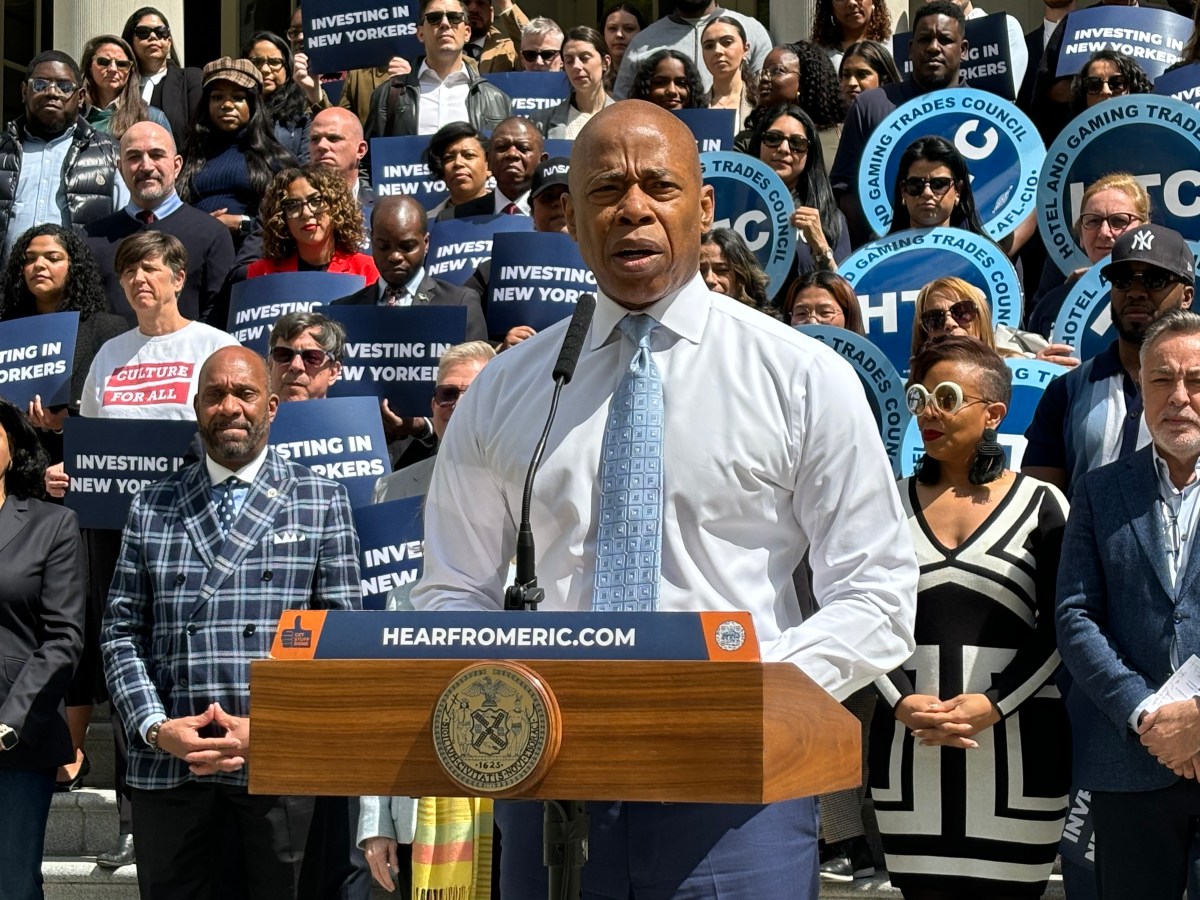The winter of Brooklyn’s discontent lingered into Wednesday as borough streets from Williamsburg to Sheepshead Bay remained unplowed more than 72 hours after the city’s fifth-worst snowstorm dumped two feet of snow.
Residents went snow blind with rage at the city’s abominably glacial response to the blizzard of 2010 — still fuming even after Mayor Bloomberg admitted on Tuesday that “some things that we probably could’ve done better.”
The mea culpa did little to warm 12th Street resident Corey Snyder, whose block between Seventh and Eighth avenues remained unplowed by midday Wednesday.
“It’s just so lame,” he said. “We’ve had deeper snowfall, but I’ve never seen the response so slow.”
Elevated subway tracks — common in the borough, though virtually unheard of in Manhattan — were rendered impassable for nearly three days. Service to most train lines was finally restored by Wednesday afternoon, but most borough buses remain in park, making travel a chore or an impossibility. One B69 bus was frozen solid to Seventh Avenue in Park Slope on Sunday and was still there on Wednesday morning, it’s flashing sign reading, “Not in Service.”
“This isn’t the worst storm we’ve ever had, but it seems to be the worst response to any major storm in recent memory,” said Councilman Steve Levin (D–Williamsburg).
Indeed, much of Brooklyn remained inaccessible by public or private transportation. Major arteries, such as Nassau Avenue in Greenpoint and Fourth Avenue in Park Slope were impassable through Tuesday.
Beyond the inconvenience of it all, the storm itself caused some serious damage. The roof of a parking garage on Second Street in Park Slope collapsed, shutting down Fourth Avenue from Atlantic Avenue to Eighth Street on Monday. Wind and snow damaged the “bubble” covers at the Prospect Park Tennis Center, which put out an all-points-bulletin for volunteers to shovel off the snow so that games could resume.
But even three days after the storm began, Union Street looked more like Crested Butte than Cobble Hill, more Catamount than Carroll Gardens. Since the storm, 76th Precinct cops — not Sanitation workers driving plows — were forced to put down their night sticks and picked up shovels to help dig out stranded residents.
“It’s been crazy here,” a police source said.
Entire neighborhoods, such as Greenwood Heights, from 24th Street to the Prospect Expressway, were unplowed. But there was finally (some) joy in Mudville on Wednesday.
“I am happy my street was cleared, especially when we know that tonier neighborhoods, mostly in Manhattan were taken care of first,” said Aaron Brashear, a Greenwood Heights activist.
But even when the plows finally showed up, they did a lousy job, Brashear observed — and documented on YouTube. “They showed up at 1:30 am, in a questionable manner that I would call ass-backward, ramming,” he charged.
But at least the Greenwood Heights plow didn’t run amok like a Sanitation tractor infamously did on Joralemon Street on Monday, laying waste to three cars as it bulled its way clear of a snow trap. The disaster was captured on YouTube and watched by 1.5 million people by Wednesday.
The borough’s predicament prompted the creation of a “wiki-map” to track — and grouse about — the city’s leisurely response to Brooklyn’s woe. By Wednesday, the map was completely covered in purple circles — an indicator of area’s still unplowed.
The neglect harkened to 1969, when just 15 inches of snow unexpectedly fell on the city, yet paralyzed Queens, whose streets remained unplowed for days. Rumor had it that sanitation workers were out to sabotage the Lindsay administration, which played hardball during a worker’s strike in 1968.
When Lindsay’s finally made it to the so-called Borough of Roses, he was jeered. In Fresh Meadows, a woman told him, “Get away, you bum.”
Borough President Markowitz branded Brooklyn 2010 the Queens of 1969. “I would doubt the Upper East Side is like this. Or the Upper West Side for that matter,” he said.
“Something happened in this snowstorm that we got behind the curve. Something came up short, and Brooklyn … took the brunt of it.”
But Sanitation officials saw things differently.
“There is no difference for any borough,” said agency spokesman Keith Mellis. “It’s the same plan we use for the entire city.”
Sanitation Commission John Doherty insisted that the culprit was simply the storm’s ferocity, though abandoned cars at a variety of intersections didn’t help the cleanup effort. “We can’t get through the streets, and that’s what’s impeding the operation in many ways,” he said Tuesday.
At the intersection of Fifth Avenue and 21st Street in the South Slope, for example, a traffic jam of abandoned cars imprisoned a plow, rendering the vehicle impotent.
The agency said it assembled 365 salt spreaders, 1,700 plows and 2,000 workers to clean up the mess. Meanwhile, Mayor Bloomberg didn’t exactly feel the borough’s pain, saying at a Monday news conference “the world has not coming to an end.”
“The city’s going on,” he added. “Many people are taking the day off. Most stores are open. There’s no reason for anyone to panic.”
Longtime Bloomberg critics such as state Sen. Carl Kruger (D–Mill Basin) pounced on the debacle, calling it a “colossal failure.”
Even a Bloomberg ally, Councilwoman Christine Quinn (D–Manhattan), called the city’s response “unacceptable,” vowing to hold hearings on Jan. 10 to investigate what went wrong.
There were five-hour delays in responding to 911 medical calls and three-hour delays responding to priority calls, such as heart attacks.
The ambulance shortage forced a Flatbush mom-to-be to improvise, hopping a ride on a fire engine get to the hospital, where she delivered a healthy baby, according to the New York Post.
But things weren’t all bad. At least not for WR Hardware on Manhattan Avenue in Greenpoint, where White Monday became Black Friday.
“People were lined up in front of the door this morning,” said manager Martin G, whose hottest sellers were ice choppers, shovels, window-washing fluid and salt. A snowstorm “always helps,” he added.
Until Wednesday, train service was suspended in much of southern Brooklyn, trapping the area in a snowy isolation.
“We haven’t been plowed and we can’t get out,” said Edith Storch, a resident of Sea Gate, a private community near Coney Island, that is without public transportation altogether. “I don’t see my way out of here. We were praying we don’t need medical care.”
Transit spokeswoman Deirdre Parker said the storm scuttled the agency’s pre-blizzard preparations, which included moving trains from outdoor yards to enclosed areas.
“It just overwhelmed our equipment,” she said. Ice on the electrified rail stalled trains, some as long as seven hours. “We had snow blowers, but at some point during a blizzard, it just blows right back.”
As of Wednesday, Brooklyn’s public transportation was emerging from its weather-induced torpor:
• The N remained suspended between Whitehall Street and Stillwell Avenue.
• Buses remained a disaster: The B1, B2, B4, B6, B9, B11, B13, B16, B20, B31, B38, B43, B44, B47, B49, B60, B61, B62, B64, B67, B68, B69, B70 and B74 were all out of service as of Wednesday afternoon.
That said, suspended train service meant a rare day of silence for those living adjacent to the elevated tracks.
“It’s very quiet here today,” said Barbara Donnelly, who has lived on E. 15th Street and Avenue P, near the Q and B trains, for the past 55 years. “It seems strange without them.”
To voice your snow removal concerns, call 311, or call Borough President Markowitz’s office at (718) 802-3777 or e-mail askmarty@brooklynbp.nyc.gov.




















